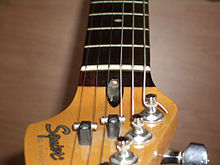Truss rod
The truss rod is a component of a guitar or other stringed instrument that stabilizes the lengthwise forward curvature (also called relief) of the neck.
Though a similar effect could be achieved with a roasted maple neck,[citation needed] truss rods are still used for precise adjustments.
Without a truss rod, the guitar's wooden neck would gradually warp (i.e. bend) beyond repair due to applied high tension.
Truss rods also allow builders to make instrument necks from less rigid materials, such as cheaper grades of wood, or man-made composites.
Without a truss rod, many of these materials would be unable to properly handle string tension at normal neck dimensions.
Before truss rods, builders had to make the neck out of very rigid woods, and achieved relief by laboriously planing the fingerboard.
Normally, turning the truss rod's adjustment bolt clockwise tightens it, counteracting the tension of the strings and straightening the neck or creating a backward bow.
Some guitars (notably Rickenbackers) come with dual truss rods that are more stable and not affected by seasonal climate changes.
Depending on the model of guitar, this bolt can be located: Modern designs also include adjustment from the side of the heel of a bolt-on neck.


